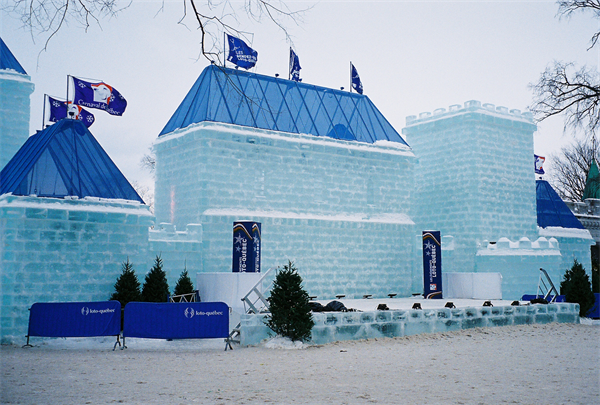- CURRENT LOCATION: HOME
- >> About Shaanxi
- >> Global Associations
- >> Sister Cities
- >>
- Xi'an
Quebec City (Canada)
2017-04-17 10:21:43 , Source : The Government Website of Shaanxi Province
Quebec City is the capital city of the Canadian province of Quebec. The city had a population estimate of 531,902 on July 2016, (Increase of 3.0% from 2011 to 2016) and the metropolitan area had a population of 800,296 on July 2016, (Increase of 4.3% from 2011 to 2016) making it Canada's seventh-largest metropolitan area and Quebec's second-largest city after Montreal.
The narrowing of the Saint Lawrence River proximate to the city's promontory, Cap-Diamant (Cape Diamond), and Lévis, on the opposite bank, provided the name given to the city, Kébec, an Algonquin word meaning "where the river narrows". Founded in 1608 by Samuel de Champlain, Quebec City is one of the oldest cities in North America. The ramparts surrounding Old Quebec (Vieux-Québec) are the only fortified city walls remaining in the Americas north of Mexico, and were declared a World Heritage Site by UNESCO in 1985 as the 'Historic District of Old Québec'.
The city's landmarks include the Château Frontenac, a hotel which dominates the skyline, and La Citadelle, an intact fortress that forms the centrepiece of the ramparts surrounding the old city. The National Assembly of Quebec (provincial legislature), the Musée national des beaux-arts du Québec (National Museum of Fine Arts of Quebec), and the Musée de la civilisation (Museum of Civilization) are found within or near Vieux-Québec.
History
Québec City is 400 years old. It boasts four centuries of history marked by encounters with the First Nations, battles between the French and English, terrible epidemics, and the acts of the men and women our streets are named after today; four centuries during which Québec has grown into the city we know and love, forging a character all its own built around a thriving culture, economic success, urban transformation, neighborhood life, and the French language.
Economy
Most jobs in Quebec City are concentrated in public administration, defence, services, commerce, transport and tourism. As the provincial capital, the city benefits from being a regional administrative and services centre: apropos, the provincial government is the largest employer in the city, employing 27,900 people as of 2007. CHUQ (the local hospital network) is the city's largest institutional employer, with more than 10,000 employees in 2007. In 2008, the unemployment rate in Quebec City was 4.5%, well below provincial and national averages (7.3% and 6.6%, respectively).
Around 10% of jobs are in manufacturing. Principal products include pulp and paper, processed food, metal/wood items, chemicals, electronics and electrical equipment, and printed materials. The city hosts the headquarters of a variety of prominent companies, including: fashion retailer La Maison Simons, engineering firms BPR and Roche Ltd, Consulting Group; investment fund Cominar; Industrial Alliance, La Capitale, Promutuel, SSQ Financial Group, and Union Canadienne in the insurance sector; Beenox, Gearbox Software, Frima Studio, Sarbakan and Ubisoft in the computer games industry; AeternaZentaris and DiagnoCure in pharmaceuticals; Amalgame, Cossette and Vision 7 in marketing and advertising; Institut National d'Optique (INO), EXFO, OptoSecurity in technology not forgetting the Desjardins Group, the area's largest employer in the financial sector.
The security and defence industries are quite prominent, and have given birth to an industrial pole: Technopôle Defence and Security.
Culture
Quebec City is known for its Winter Carnival, its summer music festival and for its Saint-Jean-Baptiste Day celebrations.
Tourist attractions located near Quebec City include Montmorency Falls, the Basilica of Sainte-Anne-de-Beaupré, the Mont-Sainte-Anne ski resort, and the Ice Hotel.
The Jardin zoologique du Québec, now closed, initially reopened in 2002 after extensive repairs before ultimately shuttering in 2006. It featured 750 specimens of 300 different species of animals. The zoo specialized in winged fauna and garden themes, but also featured several species of mammals. While it emphasized the indigenous fauna of Quebec, one of its main attractions was the Indo-Australian greenhouse, featuring fauna and flora from regions surrounding the Indian Ocean.
Parc Aquarium du Québec, which reopened in 2002 on a site overlooking the Saint Lawrence River, features more than 10,000 specimens of mammals, reptiles, fish and other aquatic fauna of North America and the Arctic. Polar bears and various species of seals of the Arctic sector and the "Large Ocean", a large basin offering visitors a view from underneath, make up part of the aquarium's main attractions. There are a number of historic sites, art galleries and museums in Québec City, including Citadelle of Quebec, Musée national des beaux-arts du Québec, Ursulines of Quebec, and Musée de la civilisation. Old Québec is a UNESCO world heritage site, with historic architecture, shops, and restaurants.
Education
The Université Laval (Laval University) is located in the western end of the city, in the borough of Sainte-Foy. However, the school of architecture of Université Laval is located at the "Vieux-Séminaire" building in Old Quebec. The main campus of the Université du Québec system is also located in Quebec City, including its specialized schools École nationale d'administration publique, Institut national de la recherche scientifique, and Télé-université (TELUQ), the distance learning component of the 'Université du Québec' network.
Numerous CEGEPs are located in Quebec city, including Collège François-Xavier-Garneau, Cégep O'Sullivan, Cégep Limoilou, Cégep de Sainte-Foy and Champlain College St. Lawrence, as well as private institutions such as Campus Notre-Dame-de-Foy, Collège Mérici, Collège Bart, Collège CDI and Collège Multihexa.
Quebec City has the oldest educational institution for women in North America, the Ursulines of Quebec monastery, located at 12 Rue Donnacona.

Government Organizations



Other Links

Copyright@www.shaanxi.gov.cn All Rights Reserved
Registration Number:陕ICP备10004160号
